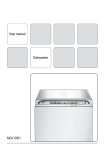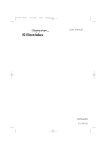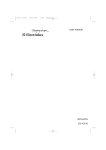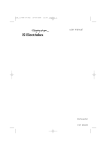Download User manual Dishwasher VA6111LT
Transcript
ATAG
User manual
Dishwasher
j
r r !fJ,
/
-~
..r.l\..A
"'DM'::~.c
.... ~;
~
~\li~
I
VA6111LT
:
2
Contents
Safety information ................................... 2
Product description ...................... .... ...... 3
Control panel ...................... .. .................. 4
First use ................................ .... .. .. ...... .. . 5
Set the water softener .............. ...... ........ 5
Use of dishwasher salt .................... .... .... 6
Use of rinse aid ....................................... 7
Daily use .......................................... ....... 8
Load cutlery and dishes .......................... 9
Use of detergent ................................... 10
Select and start a wash ing programme 11
(E
ill
rn
Unloading the dishwasher ...... .. ............ 12
Washing programmes .............. .. .. ........ 13
Care and cleaning ................................ 13
What to do if ............................. .. .... .. .. . 15
Technical data ...................................... 16
Hints for test institutes .......................... 16
Installation .............. .. ...... .. ........ .. .......... 17
Water connection ........ ................ .. ....... 18
Electrical connection .. .. .. .. ..................... 20
Environment concerns ............ .. ............ 20
Subject to change without notice
Safety informati_o_n_ _ __
In the interest of your safety and to ensure the correct use, before installing
and first using the appliance, read this
user manual carefully, including its hints
and wam ings. To avoid unnecessary
mistakes and accidents, it is important
to ensure that all people using the appliance are thoroughly fam iliar with its
operation and safety features . Save
these instructions and make sure that
they remain with the appliance if it is
moved or sold, so that everyone using it
through its life will be properly informed
on appliance use and safety.
Correct use
• This dishwasher is only intended for washing household utensils suitable for machine washing.
• Do not put any solvents in the dishwasher.
Th is could cause an explosion .
• Knives and other items with sharp points
must be loaded in the cutlery basket with
their points down or placed in a horizontal
position in the upper basket.
• Only use products (detergent, salt and
rinse aid) suitable for dishwashers.
• Avoid opening the door whilst the appliance is in operation, hot steam may escape.
• Do not take any dishes out of the
dishwasher before the end of the washing
cycle.
• After use, isolate the appliance from the
power supply and tum off the water suppy.
I
• This product shou ld be serviced only by an
authorized service eng ineer, and only
genuine spare parts should be used.
• Under no circumstances should you attempt to repair the machine yourself. Repairs carried out by inexperienced persons
could cause injury or serious malfunctioning. Contact your local Service Force Centre. Always insist on genuine spare parts.
General safety
• Dishwasher detergents can cause chemical burns to eyes , mouth and throat. Could
endanger life! Comply with the safety instructions of the dishwasher detergent
manufacturer.
• The water in your dishwasher is not for
drinking. Detergent residues may still be
present in your machine.
• Ensure that the door of the dishwasher is
always closed when it is not being loaded
or unloaded. In this way you will avoid anybody tripping over the open door and hurting themselves.
• Do not sit or stand on the open door.
Child safety
• This appliance is designed to be operated
by adults. Do not allow children to use the
dishwasher unsupervised.
• Keep all packaging well away from children. There is a risk of suffocation .
• Keep all detergents in a safe place out of
children's reach .
• Keep children well away from the
dishwasher when the door is open.
2
Contents
Safety information ................................... 2
Product description ...................... .... ...... 3
Control panel ...................... .. .................. 4
First use ................................ .... .. .. ...... .. . 5
Set the water softener .............. ...... ........ 5
Use of dishwasher salt .................... .... .... 6
Use of rinse aid ....................................... 7
Daily use .......................................... ....... 8
Load cutlery and dishes .......................... 9
Use of detergent ................................... 10
Select and start a wash ing programme 11
(E
ill
rn
Unloading the dishwasher ...... .. ............ 12
Washing programmes .............. .. .. ........ 13
Care and cleaning ................................ 13
What to do if ............................. .. .... .. .. . 15
Technical data ...................................... 16
Hints for test institutes .......................... 16
Installation .............. .. ...... .. ........ .. .......... 17
Water connection ........ ................ .. ....... 18
Electrical connection .. .. .. .. ..................... 20
Environment concerns ............ .. ............ 20
Subject to change without notice
Safety informati_o_n_ _ __
In the interest of your safety and to ensure the correct use, before installing
and first using the appliance, read this
user manual carefully, including its hints
and wam ings. To avoid unnecessary
mistakes and accidents, it is important
to ensure that all people using the appliance are thoroughly fam iliar with its
operation and safety features . Save
these instructions and make sure that
they remain with the appliance if it is
moved or sold, so that everyone using it
through its life will be properly informed
on appliance use and safety.
Correct use
• This dishwasher is only intended for washing household utensils suitable for machine washing.
• Do not put any solvents in the dishwasher.
Th is could cause an explosion .
• Knives and other items with sharp points
must be loaded in the cutlery basket with
their points down or placed in a horizontal
position in the upper basket.
• Only use products (detergent, salt and
rinse aid) suitable for dishwashers.
• Avoid opening the door whilst the appliance is in operation, hot steam may escape.
• Do not take any dishes out of the
dishwasher before the end of the washing
cycle.
• After use, isolate the appliance from the
power supply and tum off the water suppy.
I
• This product shou ld be serviced only by an
authorized service eng ineer, and only
genuine spare parts should be used.
• Under no circumstances should you attempt to repair the machine yourself. Repairs carried out by inexperienced persons
could cause injury or serious malfunctioning. Contact your local Service Force Centre. Always insist on genuine spare parts.
General safety
• Dishwasher detergents can cause chemical burns to eyes , mouth and throat. Could
endanger life! Comply with the safety instructions of the dishwasher detergent
manufacturer.
• The water in your dishwasher is not for
drinking. Detergent residues may still be
present in your machine.
• Ensure that the door of the dishwasher is
always closed when it is not being loaded
or unloaded. In this way you will avoid anybody tripping over the open door and hurting themselves.
• Do not sit or stand on the open door.
Child safety
• This appliance is designed to be operated
by adults. Do not allow children to use the
dishwasher unsupervised.
• Keep all packaging well away from children. There is a risk of suffocation .
• Keep all detergents in a safe place out of
children's reach .
• Keep children well away from the
dishwasher when the door is open.
4
Glh Q7D. g".
CD
CD
~60·
~5d'
~
_ 5
- - - - - - -- -I*
D
G,. "fI,.. ~. '=I '" ~.. !!;I _
£!::. I~
~---- *
I
I
5
--+j
PROGRAM
RESET
D On/ Off button
Ell Delay start button
II Programme selection / cancel button (PROGRAM RESET)
II Indicator lights
1.1 Programme lights
Programme lights A and B
In addition to the selection of the corresponding washing programme, these lights
will also guide you in the following operations:
- setting the water softener level,
- deactivating/activating the audible signals .
Comes on when the special salt has run out.
Salt
S
Rinse aid
Comes on when the rinse aid has run out.
·;:Y::e
End
-l
Comes on when a washing programme has ended . It also has added functions of
visual signalling as:
- the setting of the water softener,
- deactivation/activation of the audible signals,
- intervention of an alarm due to malfunction of the appliance.
Setting mode
Press the On/Off button; if ALL programme
indicator lights are off and the End indicator
light is flashing, the appliance is in setting
mode.
rn
Always remember that when performing
the following operations:
- selecting a washing programme,
- setting the water softener level,
- deactivating/ activating the audible
signals,
the appliance MUST be in setting mode.
Press the On/Off button; if a programme indicator light is on with a fixed light, the last
performed or selected programme is still set.
In this case, to return to setting mode the
programme has to be cancelled .
To cancel a set programme or a
programme in progress
Press and hold, for about 3 seconds, the
programme selection/cancel button until the
End indicator light is flashing. The programme has been cancelled and the appliance is now in setting mode.
Audible signals
Audible signals have been introduced to help
indicate w hich operations the appliance is
performi ng:
- end of the washing programme,
5
- intervention of an alarm due to malfunction
of the appliance .
rn
Factory setting: audible signals activated
It is possible to deactivate the audible
signals.
Deactivation/activation of the audible
signals
1. Press the On/Off button . The appliance
must be in setting mode.
2. Press and keep pressed the programme
selection/ cancel button until programme
light A flashes and programme light B
comes on with a fixed light.
3. Press programme selection/cancel button again . The programme light A comes
on with a fixed light and programme light
B starts flashing. Wait until programme
light A goes off. The programme light B
goes on flashing and the End indicator
light is on with a fixed light. This indicates
that you have activated the function for
deactivating/activating the audible signals, The fixed light of the End indicator
light rneans that the audible signals are
activated,
4 . To deactivate the audible signals, press
the programme selection/cancel button
again, The End indicator light goes off indicating that the audible signals are deactivated .
5, To rnemorize the operation, switch off the
appliance by pressing the On/Off button.
• To activate again the audible signals simply follow the above operations until the
End ind icator light comes on,
First use
Before using your dishwasher for the first
time :
• Ensure that the electrical and water connections comply with the installation instructions
• Remove all packaging from inside the appliance
• Set the water softener level
• Pour 1 litre of water into the salt container
and then fill with dishwasher salt
• Fill the rinse aid dispenser
rn
If you want to use combi detergent
tablets such as: "3 in 1", "4 in 1" , "5
in 1" etc ... follow the instructions
given in "Use of detergent".
Set the water softener
The dishwasher is equipped with a water
softener designed to remove minerals and
salts from the water supply, which would
have a detrimental or adverse effect on the
operation of the appliance .
The higher the content of these minerals and
salts, the harder your water is. Water hardness is measured in equivalent scales, German degrees (d HO), French degrees (OTH)
and mmol/I (millimol per litre - international
unit for the hardness of water) .
The softener should be adjusted according
to the hardness of the water in your area,
Your local Water Authority can advise you on
the hardness of the water in your area,
rn
The water softener must be set in two
ways: manually, using the water hardness dial and electronically.
!.;:..,'¥.'. :~~~~e,~ ~ardne~.~
,.1; ",odH : .,
'J
\;'.,.:
I~ TH ,
';f
ml1)ol/l
51 - 70
91 - 125
9,1 -12,5
2
level 10
43 - 50
76 - 90
7,6 - 9,0
2
level 9
yes
yes
37 - 42
65 -75
6,5 -7,5
2
level 8
yes
29 - 36
51 - 64
5,1 - 6,4
2
level 7
yes
23 - 28
40 - 50
4,0 - 5,0
2
level 6
yes
19 - 22
33 - 39
3,3 - 3,9
2
level 5
yes
15 - 18
26 - 32
2,6 - 3,2
level 4
yes
6
7 - 18
<4
<7
< 0,7
Setting m anually
rn
The dishwasher is factory set at position
2.
1. Open the dishwasher door.
2. Remove the lower basket from the
dishwasher.
'
3. Turn the water hardness dial to position
1 or 2 (see chart) .
4. Replace the lower basket.
Setting electronically
rn
yes
0,7 - 1,8
The dishwasher is factory set at level 5.
1. Press the On/ Off button. The dishwasher
must be in setting mode.
2. Press and keep pressed the programme
selection/ cancel button until programme
light A flashes and programme light B
comes on with a fixed light. Wait until programme light B goes off. The programme
level 1
no
light A goes on flashing and
simultaneously the End indicator light
starts flashing. Wait until programme light
B goes off. the programme light A goes
on flashing and simultaneously the End
indicator light starts flashing. This indicates that you have activated the
electronic setting function of the water
softener. The current level is indicated by
the number of flashes of the End indicator light and a pause of a few seconds .
Examples:
5 flashes, pause, 5 flashes , pause, etc. =
level 5
6 flashes, pause, 6 flashes, pause, etc. =
level 6
3. To change the level, press the programme selection/cancel button . Each
time the button is pressed the level
changes. (For the selection of the new
level see the chart).
Examples :
if the current level is 5, by pressing programme selection/ cancel button once,
level 6 is selected,
if the current level is 10, by pressing programme selection/cancel button once,
level 1 is selected .
4. To memorize the operation, switch off the
dishwasher by pressing the On/ Off button .
Use of dishwasher salt
ill Warning!
Only use salt specifically designed for use in
dishwashers. All other types of salt not
specifically designed for use in a dishwasher,
especially table salt, will damage the water
softener. Only fill with salt just before starting
one of the complete washing programmes.
This will prevent any grains of salt or salty
water, which may have been spilt , remaining
on the bottom of the machine for any period
of time, which may cause corrosion .
To fill :
1. Open the door, remove the lower basket
and unscrew the cap of the salt container
by turning it anticlockwise.
2. Pour 1 litre of water into the container
(this is necessary on ly before fi lling
with salt for the first time) .
3. Using the funnel provided, pour in the salt
until the container is full.
7
5. Replace the cap tightly tum ing it clockwise until it stops with a click .
rn
rn
Do not worry if water overflows from the
unit when filling with salt, this is quite
normal.
The salt indicator light on the control
panel can remain illuminated for 2-6
hours after the salt has been
replenished, assuming the
dishwasher remains switched on. If
you are using salt that takes longer
to dissolve then this can take longer.
The operation of the machine is not
affected.
4. Replace the cap making sure that there
is no trace of salt on the screw thread or
on the gasket.
Use of rinse aid
&
rn
Warning! Only use branded rinse aid for
dishwashers.
Never fill the rinse aid dispenser with any
other substances (e.g . dishwasher
cleaning agent, liquid detergent). Th is
would damage the appliance.
Rinse aid ensures thorough rinsing , and
spot and streak free drying .
Rinse aid is automatically added during
the last rinse.
1. Open the container by pressing the release button (A).
~jr.
2. Add the rinse aid in th e container. The
maximum level for filling is indicated by
"maxI! ,
The dispenser holds about 110 ml of rinse
aid, wh ich is sufficient for between 16 and
40 washing cycles, depend ing upon the
dosage setting .
3. Ensure that the lid is closed after every
refill.
rn
Clean up any rinse aid spilt during filling
with an absorbent cloth to avoid excess
foam ing during the next wash.
According to the finish and drying results obtained, adjust the dose of rinse aid by means
of the 6 position selector (position 1 minimum
dosage, position 6 maximum dosage).
The dose is facto ry set in position 4.
Increase the dose if there are drops of water
or lime spots on the dishes after washing .
8
Reduce it if there are sticky whitish streaks
on the dishes or a bluish film on glassware or
knife blades.
Da!!l.use
• Check if it's necessary to refill with
dishwasher salt or rinse aid.
• Load cutlery and dishes into the
dishwasher.
• Fill with dishwasher detergent.
• Select a wash programme suitable for the
cutlery and dishes.
• Start the wash programme.
Helpful hints and tips
Sponges, household cloths and any object
that can absorb water may not be washed in
the dishwasher.
• Before loading the dishes, you should:
- Remove all left over food and debris.
- Soften remnants of burnt food in pans
• When loading the dishes and cutlery,
please note:
- Dishes and cutlery must not irnpede the
rotation of the spray arms.
• Cutlery with wooden, horn, china or mother-ofpearls handles.
• Plastic items that are not heat resistant.
• Older cutlery with glued parts that are not
temperature resistant.
• Bonded cutlery items or dishes.
• Pewter or copper items.
• Lead crystal glass.
• Steel items prone to rusting .
• Wooden platters.
• Items made from synthetics fibres.
- Load hollow items such as cups,
glasses, pans, etc. with the opening
downwards so that water cannot collect
in the container or a deep base.
- Dishes and items of cutlery must not lie
inside one another, or cover each other.
- To avoid damage to glasses, they must
not touch.
- Lay small objects in the cutlery basket.
• Plastic items and pans with non stick coatings have a tendency to retain water
drops; these items will not dry as well as
porcelain and steel items.
• Light items (plastic bowls etc.) must be
loaded in the upper basket and arranged
so they do not move.
• Only wash stoneware in the dishwasher if it is
specially marked as being dishwasher-safe by
the manufacturer.
• Glazed patterns may fade if machine washed
frequently.
• Silver and aluminium parts have a tendency to
discolour during washing: Residues, e.g. egg
white, egg yolk and mustard often cause discolouring and staining on silver. Therefore always clean left-overs from silver immediately, if
it is not to be washed straight after use.
9
Load cutlery and dishes
The lower basket
The lower basket is designed to take saucepan, lids, plates, salad bowls, cutlery etc .
The rows of prongs on the right side in the
lower basket can lie flat to allow you to load
pots, pans and bowls.
If the handles protrude from the bottom of the
basket, obstructing the lower spray arm, load
the cutlery with the handles facing upwards.
Mix spoons with other cutlery to prevent
them from sticking together.
For best results we recommend that you use
the cutlery grids (if the size and dimensions
of the cutlery allow it).
The cutlery basket
ill Long bladed knives stored in an upright
.
position are a potential hazard. Long
and/or sharp items of cutlery such as
caNing knives must be positioned
horizontally in the upper basket. Take
care when loading or unloading sharp
items such as knives.
Forks and spoons must be placed in the
removable cutlery basket with the handles
facing downwards and the knives with their
handles fac ing upwards.
For larger utensils use only 1 grid.
The upper basket
The upper basket is designed for saucers,
salad bowls, cups, glasses, pots and lids.
Arrange items on and underneath the cup
racks so that water can reach all surfaces .
10
With upper basket
raised
30 em
With upper basket
lowered
29 em
To move to the higher position proceed
as follows:
1. Pullout the basket until it stops.
2. Hold the upper basket by the handle on
the side.
3. Carefully lift up the basket until it stops.
Glasses with long stems can be placed upside down in the cup racks. For taller items
the cup racks can be folded upwards.
4. Lower it vertically. The mechanism will
engage the basket in the higher or lower
position.
CD Before closing the door, ensured that
the spray arms can rotate freely.
Adjusting the height of the upper basket
If washing very large plates you can load
them in the lower basket after moving the
upper basket to the higher position.
Use of~etergent
CD Only use detergents specifically de-
signed for use in dishwashers.
Please observe the manufacturer's dosing and storage recommendations as
stated on the detergent packaging.
~ Using no more than the correct amount
of detergent contributes to reducing pollution.
Fill with detergent
1. Open the lid.
it After loading your machine always
close the door, as an open door can
be a hazard.
11
2. Fill the detergent dispenser (1) with detergent. The marking indicates the dosing
levels:
20 = approximately 20 g of detergent
30 = approximately 30 g of detergent.
3. All programmes with prewash need an
additional detergent dose (5/10 g) that
must be placed in the prewash detergent
chamber (2).
This detergent will be used during the
prewash phase.
When using detergent tablets; place the
tablet in com artm ent (1)
4. Close the lid and press until it locks in
place .
rn
Select the washing programme with
the door slightly opened. The start of
the programme will occur only after
the closure of the door. Until then it
is possible to modify the settings.
rn
Detergent tablets from different manufacturers dissolve at different rates. For
this reason, some detergent tablets do
not attain their full cleaning power during
short washing programmes. Therefore,
please use long washing programmes
when using detergent tablets, to ensure
the complete removal of detergent
residuals.
Use of combi detergent tablets
These products are detergents with a com bined cleaning, rinsing and salt functions.
They can also contain other different agents
depending on which kind of tablets you
choose ("3 in 1 ", "4 in 1 ", "5 in 1" etc ... ).
1. Check whether these detergents are
suitable for your water hardness. See the
manufacturers instructions.
The refilling of the salt container and the
rinse aid dispenser are no longer
necessary. In this case the rinse aid indicator light will always remain illuminated
when the machine is switched on.
2. Select the lowest setting for water hardness and rinse aid dosage.
If the drying results are not satisfactory
we recommend that you:
1. Fill up the rinse aid dispenser with rinse
aid.
2. Set the rinse aid dosage to position 2.
If you decide to turn back to the use of
standard detergent system we advise
that you:
1. Fill up the dispensers for salt and rinse aid
again .
2. Adjust the water hardness setting to the
highest setting and perform 1 normal
washing programme without loading any
dishes.
3. Adjust the water hardness setting according to the hardness of the water in
your area.
4. Adjust the rinse aid dosage.
1. Check that the baskets have been loaded
correctly and that the spray arms are free
to rotate.
2. Check that the water tap is opened.
12
3. Press the On/ Off button. The dishwasher
must be in setting mode.
4. Press the programme selection/ cancel
button until the light corresponding to the
requ ired washing programme comes on
(see "Washing programmes" chart).
Close the dishwasher door, the programme starts automatically.
Setting and starting the programme with
delay start
CIl The start of the washing programme w ill
be delayed by 3 hours.
1. Select a washing programme.
2. Press the delay start button. The corresponding indicator light comes on.
3 . Close the dishwasher door. The countdown starts automatically.
CIl Opening the door will interrupt the
countdown . Once the door is closed the
countdown will continue from the point
at which it was interrupted.
4 . Once the countdown has elapsed the
washing programme will start
automatically.
Cancel a delay start in progress
1. Open the dishwasher door.
2. Press the delay start button. The corresponding indicator light goes off.
3. Close the dishwasher door. The washing
programme will start automatically.
ill Warning! Interrupt or cancel a
Interrupt a washing programme in
progress
Open the dishwasher door; the programme
will stop. Close the door; the programme will
start from the point at which it was interrupted.
Cancel a washing programme in
progress
• Open the dishwasher door; press the programme selection/ cancel button for about
3 seconds, until the light of the runn ing
programme goes off and the End indicator
light flashes. The washing programme has
been cancelled and the appliance is now
in setting mode ..
• If a new washing programme is to be selected , check that there is detergent in the
detergent dispenser.
End of the washing programme
• The dishwasher will automatically stop and
an audible signal informs you of the end of
the washing programme.
• Open the dishwasher door.
• The End of programme indicator light is
on.
• The indicator light of the programme just
ended remains on.
1. Switch off the dishwasher by pressing the
On/ Off button .
2. Leave the dishw asher door ajar and wait
a few minutes before removing the
dishes; in this way they will be cooler and
the drying will be improved.
washing programme in progress
ONLY if it's absolutely necessary.
Attention! Hot steam may escape
when the door is opened. Open the
door carefully.
Unloading the dishwasher
• Hot dishes are sensitive to knocks. The
dishes should therefore be allowed to cool
down before removing from the appliance.
• Empty the lower basket first and then the
upper one; this will avoid water dripping
from the upper basket onto the dishes in
the low er one.
• Water may appear on the sides and the
door of the dishwasher as the stainless
steel w ill eventually become cooler than
the dishes.
CIl When the washing programme has
finished, it is recommended that the
dishwasher is unplugged and the
water tap turned off.
13
Washing programmes
Washing programmes
Type of load
Programme
Q
Intensive 70°
g
Normal 65°
-
Programme description
Heavy soil
Crockery, cutlery,
pots and pans
Prewash
Main wash
2 intermediate rinses
Final rinse
Drying
Normal soil
Crockery, cutlery,
pots and pans
Prewash
Main wash
1 intermediate rinse
Final rinse
Drying
Normal or light
soil
Crockery and
cutlery
Main wash
Final rinse
Normal soil
Crockery and
cutlery
Prewash
Main wash
1 Intermediate rinse
Final nnse
Drying
Any
Partial load (to be
completed later in
the day).
~
Quick 60°
1)
~
Eco 50'
2)
~
Rinse and Hold
1 cold rinse (to avoid food scraps from
sticking).
This programme does not require the use
of detergent.
1) Ideal for washing a partially loaded dishwasher. This is the perfect daily programme, made to meet
the needs of a family of 4 persons who only wish to load breakfast and dinner crockery and cutlery.
2) Test programme for test institutes
Consumption values
. ..
:
l
ater consumption
'~ (in litres)
,.
It,i l)
Intensive 70°
120 - 130
1,8 - 2,0
Normal 65°
100-110
1,4-1,6
Quick 60°
30
0,9
9
Eco 50°2)
130 - 140
1,0 - 1.2
14 - 16
12
0.1
5
Rinse and Hold
22 - 24
19 - 21
1) The consumption values are intended as a guide and depends on the pressure and the temperature
of the water and also by the variations of the power supply and the amount of dishes
2) Test programme for test institutes
Care and cleaning
Cleaning the filters
The filters must be checked and cleaned
from time to time. Dirty filters will degrade the
washing result.
ill Warning! Before cleaning the filters
ensure that the machine is switched off.
1. Open the door, remove the lower basket.
2. The dishwasher filter system comprises a
coarse filter (A), a microfilter (8 ) and a flat
filter. Unlock the filter system using the
handle on the microfilter.
14
8. Place the coarse filter (A) in the microfilter
(8 ) and press together.
9. Put the filter combination in place and
lock by turning the handle clockwise to
the stop . During this process ensure that
the flat filter does not protrude above the
base of the washing compartment.
A
rn
-'H---B
3. Turn the handle about 1/4 a turn anticlockwise and rernove the filter systern
rn
NEVER use the dishwasher without filters. Incorrect repositioning and fitting of
the filters will produce poor washing results and will result in damage to the
appliance
NEVER try to remove the spray
arms.
If residues of soil have clogged the holes
in the spray arms , remove the debris
with a cocktail stick.
External cleaning
Clean the external surfaces of the machine
and control panel with a damp soft cloth. If
necessary use only neutral detergents. Never
use abrasive products, scouring pads or solvent (acetone, trichloroethylene etc ... ).
4. Take hold of the coarse filter (A) by the
handle with the hole and rernove from the
microfilter (8 ).
5. Clean all filters thoroughly under running
water.
6. Remove the flat filter from the base of the
washing compartment and clean both
faces thoroughly.
Internal cleaning
Ensure that the seals around the door, the
detergent and rinse aid dispensers are
cleaned regularly with a damp cloth.
We recommend every 3 months you run the
wash programme for heavy soiled dishes using detergent but without dishes.
Prolonged periods of non-operation
If you are not using the machine for a prolonged period of time you are advised to:
1. Unplug the appliance and then turn off
the water.
2. Leave the door ajar to prevent the formation of any unpleasant smells.
3. Leave the inside of the machine clean.
Frost precautions
Avoid placing the machine in a location
where the temperature is below
If this is
unavoidable, empty the machine, close the
appliance door, disconnect the water inlet
pipe and empty it.
aoc.
\
7. Put the flat filter back in the base of the
washing compartment and ensure that it
fits perfectly.
Moving the machine
If you have to move the machine (moving
house etc ... ):
1. Unplug it.
2. Turn the water tap off.
15
3. Remove the water inlet and discharge
hoses.
4. Pull the machine out together with the
hoses.
Avoid over tilting the machine during transportation.
What to do if ...
The dishwasher will not start or stops during
operation.
Certain problems can be due to the lack of
simple maintenance or oversights , which can
be solved with the help of the hints described
in the chart, w ithout calling out an eng ineer.
Switch off the dishwasher and carry out the
fo llowing suggested corrective actions .
• continuous flashing of the light of the running
programme
• intermittent audible signal
• 1 flash of the End indicator light
The dishwasher does not fill with water
• The water tap is blocked or furred with timescale.
Clean the water tap.
• The water tap is turned off.
Turn the water tap on.
• The filter (where present) in the threaded inlet
hose is blocked.
Clean the filter.
• The water inlet hose has not been correctly laid
or it is kinked or squashed.
Check the water Inlet hose connection .
• continuous flashing of the tight of the running
programme
• intermittent audible signal
• 2 flashes of the End indicator tight
The dishwasher will not drain
• The sink spigot IS blocked.
Clean out the Sink spigot.
• The water drain hose has not been correctly laid
or It is kinked or squashed.
Check the water drain hose connection.
• continuous flashing of the light of the running
programme
• intermittent audible signal
• 3 flashes of the End indicator tight
Anti-flood device is activated
• Close the water tap and contact your local
Service Force Centre.
The programme does not start
• The dishwasher door has not been properly
closed.
Close the door.
• The main plug is not plugged in.
Insert the main plug
• The fuse has blown out in the household fuse
box.
Replace the fuse.
• Delay start has been set. If dishes are to be
washed immediately, cancel the delay start.
Once these checks have been carried out
switch on the appliance.
The programme w ill continue from the point
at wh ich it was interrupted.
If the malfunction or fault code reappears
contact your local Service Force Centre.
For other fau lt codes not described in the
above chart , please contact your local Service Force Centre.
Contact your local Servi ce Force Centre,
quoting the model (Mod .). product number
(PNC) and serial number (S.N.).
This information can be found on the rating
plate located on the side of the dishwasher
door.
So that you always have these numbers at
hand, we recommend you to make a note of
them here:
Mod.: ... . . ... ....... . .... ...... . . . .
PNC: .. . . . .. . . . ... .. .. . .. ... .. .... .
16
S.N.: .. . .. . .. . ..... . . ...... . ... . .. .
The wash results are not satisfactory
The dishes are not
clean
• The wrong programme has been selected.
• The dishes are arranged in such a way as to stop water reaching all parts
of a surface. The baskets must not be overloaded .
• The spray arms do not rotate freely due to incorrect arrangement of the
load.
• The filters in the base of the washing compartment are dirty or incorrectly
positioned.
• Too little or no detergent has been used.
• Where there are limescales deposits on the dishes; the salt container is
empty or incorrect level of the water softener has been set.
• The drain hose connection is not correct.
• ,The salt container cap is not properly closed.
The dishes are wet
and dull
• Rinse aid was not used.
• The rinse aid dispenser is empty.
There are streaks,
milky spots or a bluish coating on
glasses and dishes
• Decrease rinse aid dosage.
Water drops have
dried onto glasses
and dishes
• Increase rinse aid dosage.
• The detergent may be the cause. Contact the detergent manufacturer
consumer care line.
If after all these checks , the problem persists ,
contact your local Service Force Centre.
Technical data
Width
Height
Depth
Dimensions
59,6 cm
81 ,8 - 89,8 cm
55,5 cm
Electrical connection - Voltage - Information on the electrical connection is given on the rating plate
Overall power - Fuse
on the inner edge of the dishwasher door.
Water supply pressure
Minimum
Maximum
0,05 MPa (0,5 bar)
0,8 MPa (8 bar)
Capacity
12 place settings
.---.-~
Hints for test institutes
Testing in accordance with EN 60704 must
be carried out with appliance fully loaded and
using the test programme (see "Consumpt ion values").
Test in accordance with EN 50242 must be
carried out when the salt container and rinse
~'!l""·:~i.~"I.'·l":'
It'h ,
~)
'.
::~
~ t
aid dispenser have been filled with salt and
rinse aid respectively and using the test programme (see "Consumption values").
. ('~ Fullioad: 12 standard nlace
settings
~
Amount of detergent required:
5 g + 25 g rrype B)
Rinse aid setting
position 4 rrype III)
17
Arrangement lower basket
Arrangement cutlery basket
rn
Remove cup racks on the left-hand side
of the upper basket.
Installation- - - - -
&
Warning ! Any electrical and/or
plumbing work required to install
this appliance should be carried out
by a qualified electrician and/or
plumber or competent person.
Remove all packaging before positioning the
machine.
If possible, position the machine next to a
water tap and a drain.
This dishwasher is designed to be fitted un der a kitchen counter or work surface.
Attention! Carefully follow the instructions
on the enclosed template for building in the
dishwasher and fitting the fumiture panel.
No further openings for the venting of the
dishwasher are req uired, but only to let the
water fill and drain hose and power supply
cable pass through.
The dishwasher incorporates adjustable feet
to allow the adjustment of the height.
During all operations that involve accessibility
to intemal components the dishwasher has
to be unplugged .
When inserting the machine, ensure that the
water inlet hose, the drain hose and the supply cable are not kinked or squashed.
Fixing to the adjacent units
The dishwasher must be secured against tilting.
Therefore make sure that the counter it is
fixed under, is suitably secured to a fixed
structure (adjacent kitchen units cabinets,
wall).
Levelling
Good levelling is essential for correct closure
and sealing of the door.
18
When the appliance is correctly levelled, the
door will not catch on either side of the cabinet.
If the door does not close correctly, loosen
or tighten the adjustable feet until the machine is perfectly level.
Water connection
Water inlet connection
This dishwasher may be fed with either hot
(max. 60°) or cold water. Nevertheless we
advise you use a cold water supply.
A hot water supply is not always efficient with
heavily soiled crockery as it shortens the
washing programmes a lot.
For making the connectlon itself, the cou pling nut fitted to the machine's inlet hose is
designed to screw onto a 3/4" gas thread
spout or to a purpose made quick-coupling
tap such as the Press-block.
The water pressure must be within the limits
given in the "Technical data". Your local Water Authority will advise you on the average
mains pressure in your area.
The water inlet hose must not be kinked,
crushed , or entangled when it is being connected.
The dishwasher features inlet and drain hoses which can be turned either to the left or
the right to suit the installation by means of
the locknut. The locknut must be
correctly fitted to avoid water leaks.
rn
Attention! NOT all models of dishwashers have inlet and drain hoses provided
with a locknut. In this case, this facility is
not available.
If the machine is connected to new pipes or
pipes which have not been used for a long
time, you should run the water for a few minutes before connecting the inlet hose.
DO NOT use connection hoses which
have previously been used on an old appliance.
rn
This appliance has been fitted with
safety features which will prevent the
water used in the appliance from returning back into the drinking water system.
This appliance complies with the applicable plumbing regulations.
Water inlet hose with safety valve
After connecting the double-walled water inlet hose, the safety valve is next to the tap.
Therefore the water inlet hose is only under
pressure while the water is running. If the wa-
ter inlet hose starts to leak during this operation, the safety valve cuts off the running
water.
Please take care when installing the water
inlet hose:
• The electrical cable for the safety valve is
in the double-walled water inlet hose. Do
not immerse the water inlet hose or the
safety valve in water.
• If water inlet hose or the safety valve is
damaged, remove the mains plug
immediately.
• A water inlet hose with safety valve must
only be replaced by the Service Force
Centre.
it Warning! Dangerous voltage
Water drain connection
The end of the drain hose can be connected
in the following ways:
1. To the sink outlet spigot, securing it to the
underside of the work surface . This will
prevent waste water from the sink running into the machine.
2. To a stand pipe provided with venthole,
minimum internal diameter 4 crn.
The waste connection must be at a height of
between 30 cm (minimum) and 100 cm
(maximum) from the bottom of the
dishwasher.
19
When connecting the drain hose to an under
sink trap spigot. the entire plastic membrane (A) must be removed. Failure to remove all the membrane will result in food
particles building up over time eventually
blocking the dishwasher drain hose spigot
A
I:;::.
The drain hose can face either to the right or
left of the dishwasher
Ensure the drain hose is not bent or
squashed as this could prevent or slow down
the discharge of water.
The sink plug must not be in place when the
machine is draining as this could cause the
water to syphon back into the machine.
If you use a drain hose extension it must be
no longer than 2 metres and its internal
diameter must be no smaller than the diameter of the hose provided.
Likewise the intern al diameter of the couplings used for connections to the waste
outlet must be no smaller than the diameter
of the hose provided .
rn
rn
Our appliances are supplied with a
security device to protect against the return of dirty water back into the machine.
If the spigot of your sink has a "no retum
valve" incorporated this can prevent the
correct draining of your dishwasher. We
therefore advise you to remove it.
To avoid water leakage after installation
make sure that the water couplings are
tight.
20
Electrical connection
it Warning! Safety standards require
the appliance to be earthed.
Prior to using the appliance for the
first time, ensure that the rated voltage and type of supply on the rating
plate match that of the supply where
the appliance is to be installed. The
fuse rating is also to be found on the
rating plate.
Always plug the mains plug into a
correctly installed shockproof
socket.
'
Multi-way plugs, connectors and extension cables must not be used.
This could constitute a fire hazard
through overheating.
If necessary, have the domestic wiring system socket replaced. In case
that the electrical cable has to be
replaced , contact your local Service
Force centre.
The plug must be accessible after
the appliance has been installed.
Never unplug the appliance by pulling on the cable. Always pull the
plug.
The manufacturer accepts no
liability for failure to observe the
above safety precautions.
Environment concerns
'~
.)
The symbol )~ on the product or on its
packaging indicates that this product may
not be treated as household waste . Instead
it should be taken to the appropriate
collection point for the recycling of electrical
and electronic equipment. By ensuring this
product is disposed of correctly, you will help
prevent potential negative consequences for
the environment and human health, which
could otherwise be caused by inappropriate
waste handling of this product. For more
detailed information about recycling of this
product, please contact your local council,
your household waste disposal service or the
shop where you purchased the product.
Packaging material
The packaging materials are environmentally
friendly and can be recycled, The plastic
components are identified by markings, e,g.
>PE<, >PS<, etc, Please dispose of the
packaging materials in the appropriate
container at the community waste disposal
facilities,
it Warning! When a unit is no longer being
used :
• Pull the plug out of the socket.
• Cut off the cable and plug and dispose
of them,
• Dispose of the door catch, This prevents children from trapping them selves inside and endangering their
lives,
Nederland
Home Product Service (ATAG)
Postbus 249
6920 AE DUIVEN
tel: 0900 - 5550001
fax : 026 - 8821444
Belgie
ATAG Belgie NV
9420 Erpe-Mere
tel: 053 - 806208
fax: 053 - 806057
ATAG
Post bus 1033 • 6920 BA Duiven • Nederland
11 7970490 - 00 - 022008
































